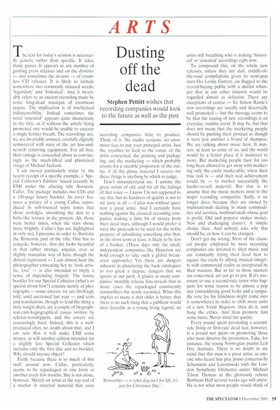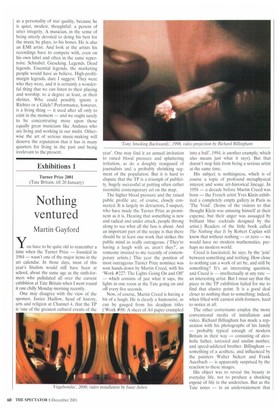Dusting off the dead
Stephen Pettitt wishes that recording companies would look to the future as well as the past
The text for today's sermon is necessarily generic rather than specific. It takes many guises. It appears in any number of gushing press releases and on the derrieres — and sometimes the devants — of countless CD releases. It is likely to include somewhere two commonly misused words: 'legendary' and 'historical'. And it invariably refers to an ancient recording made by some long-dead musician of enormous repute. The implication is of intellectual indispensability. Indeed sometimes the word 'essential' appears quite shamelessly in the title, as if without the article being promoted one would be unable to execute a single further breath. The recordings are, we are invariably assured, carefully digitally remastered with state of the art hiss-andscratch removing equipment. For all that, their vintage is concealed about as convincingly as the much-lifted and plasticised visage of Michael Jackson.
I am moved particularly today by the recent receipt of a specific example, a 'Special Collector's Edition' issued recently by EMI under the alluring title Romantic Callas. The package includes two CDs and a 100-page luxury booklet. Its cover features a picture of a young Callas, reproduced in soft-focused sepia tones that shout nostalgia, smoothing the skin to a baby-like texture in the process. Ah, those were better times, when the stars shone more brightly. Callas's lips are highlighted in ruby red, I presume in order to illustrate the Romantic part of the title. One has to concede, however, that she looks beautiful in that rather strange, angular, ever so slightly masculine way of hers, though the distant expression — I can almost hear the photographer entreating her to 'look artistic, love' — is also intended to imply a sense of impending tragedy. The luxury booklet for our Special Collector (what's so special about him?) consists mostly of photographs — some unseen, we are thrillingly told, until auctioned last year — and texts and translations, though to lend the thing a little weight there are a couple of biographical-cum-hagiographical essays written by scholar-worshippers, and the covers are reassuringly hard. Indeed, this is a wellproduced objet, no doubt about that, and I am sure that it will make EMI some money, as will another edition intended for a slightly less Special Collector which includes only the first disc and no booklet. Why should anyone object?
Partly because there is so much of this stuff around now. Callas, particularly, seems to be repackaged in one form or another every few months. She is not alone, however. Merely an artist at the top end of a market in recycled material that costs recording companies little to produce. Think of it. No studio sessions, no enormous fees to pay your principal artist. Just the royalties to feed to the estate of the artist concerned, the printing and packaging, and the marketing — which probably counts for a sizeable proportion of the outlay, if all the glossy material I receive for these things is anything by which to judge.
Don't misunderstand me. I admire the great artists of old, and for all the failings of that voice — I know I'm not supposed to say this, but its hardness of quality is not to my taste at all — Callas was without question a great artist. And I certainly have nothing against the classical recording companies making a little bit of money from their dead stars, although I would prefer it were the proceeds to be used for the noble purpose of subsidising something else that, in the short term at least, is likely to be less of a banker. (These days only the small, independent companies like Hyperion are bold enough to take such a global breakeven approach.) Yet there are dangers inherent in plundering the back catalogues to too great a degree, dangers that we ignore at our peril. A glance at many companies' monthly release lists reveals that in many cases the repackaged consistently outnumbers the newly recorded. What this implies to many is that older is better, that there is no such thing that a publicist would dare describe as a young living legend, an artist still breathing who is making 'historical' or 'essential' recordings right now.
To compound this, on the whole new releases, unless they are dull, middle-ofthe-road compilations given by semi-pop stars like Lesley Garrett, are flagged to the record-buying public with a dutiful whimper that in any other industry would be regarded almost as defeatist. There are exceptions of course — Sir Simon Rattle's new recordings are usually and deservedly well promoted — but the message seems to be that the issuing of new recordings is an everyday, routine event. It may be, but that does not mean that the marketing people should be pushing their product as though it were just another a brand of shampoo. We are talking about music here. It matters, at least to some of us, and the world would be a better place if it mattered to more. But marketing people have for too long been allowed to get away with marketing only the easily marketable, when their true task is — and their real achievement would be — to market successfully the harder-to-sell material. But that is to assume that the music matters most to the major recording companies. Sadly, it no longer does, because they are owned by multinationals dealing in many commodities and services, multinationals whose goal is profit. Old and popular makes money. New and challenging doesn't. A simple choice then. And nobody asks why this should be, or how it can be changed.
Don't get me wrong. Most of the classical people employed by most recording companies are devoted to their music and are constantly trying their level best to square the circle by allying musical integrity with commercial reality as interpreted by their masters. But as far as those masters are concerned, art can go to pot. If it's necessary to use a second-rate tenor who happens for some reason to be almost a pop star (smouldering good looks and a sympathy vote for his blindness might come into it somewhere) in order to shift more units of a new Verdi Requiem, then do it, and hang the critics. And then promote him some more. Never mind the quality.
Every pound spent promoting a secondrate living or first-rate dead star, however, is a pound not spent on promoting those who most deserve the promotion. Take, for instance, the young Norwegian pianist Leif Ove Anclsnes. There is no doubt in my mind that this man is a great artist, as anyone who heard him play piano concertos by Schumann and Lutoslawski with the London Symphony Orchestra under Michael Tilson Thomas at the gloriously reborn Barbican Hall several weeks ago will attest. He is not what most people would think of as a personality of star quality, because he is quiet, modest, thoughtful: a person of utter integrity. A musician, in the sense of being utterly devoted to doing his best for the music he plays, to his bones. He is also an EMI artist. And look at the artists his recordings have to compete with, even on his own label and often in the same repertoire. Schnabel. Gieseking. Legends. Dead legends. Essential legends, the marketing people would have us believe. High-profitmargin legends, dare I suggest. They were who they were, and it is certainly a wonderful thing that we can listen to their playing and worship, to a degree at least, at their shrines. Who could possibly ignore a Richter or a Gilels? Performance, however. is a living thing — it used after all only to exist in the moment — and we ought surely to be concentrating more upon those equally great musicians like Andsnes who are living and working in our midst. Otherwise the art of serious music-making will deserve the reputation that it has in many quarters for living in the past and being irrelevant to the present.























































































 Previous page
Previous page